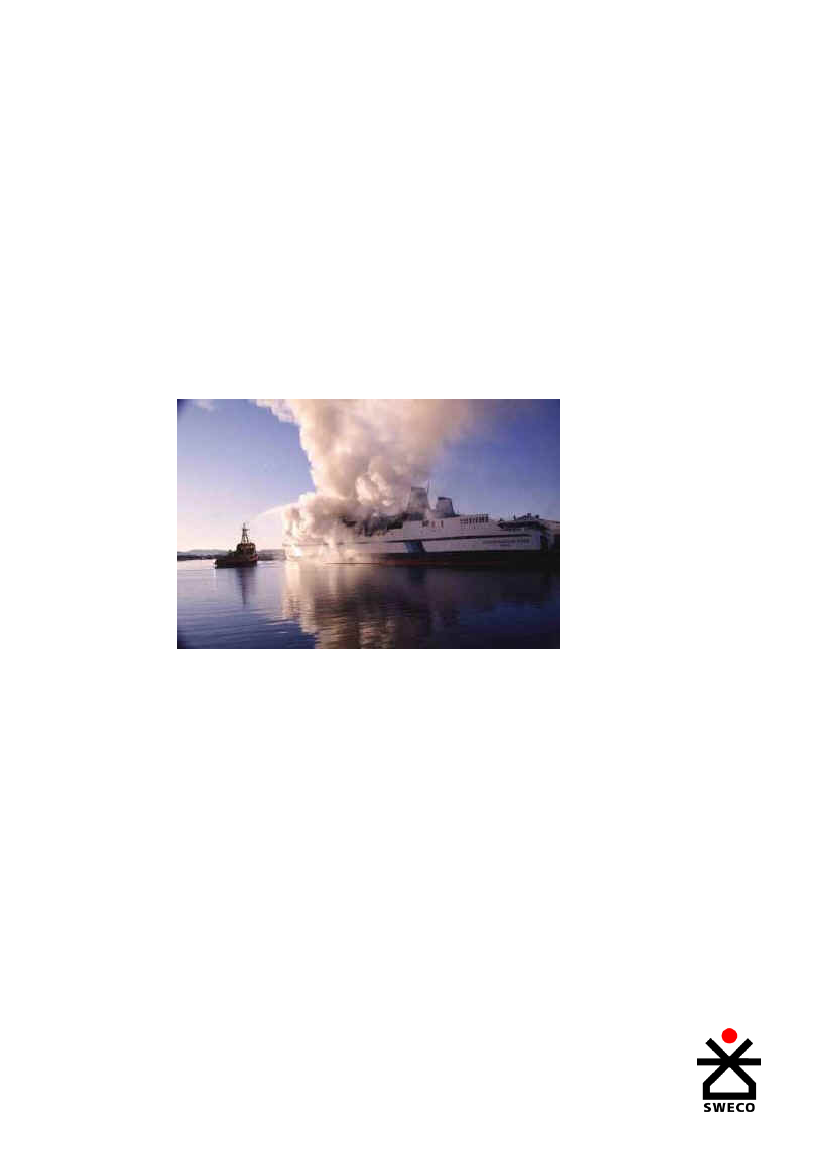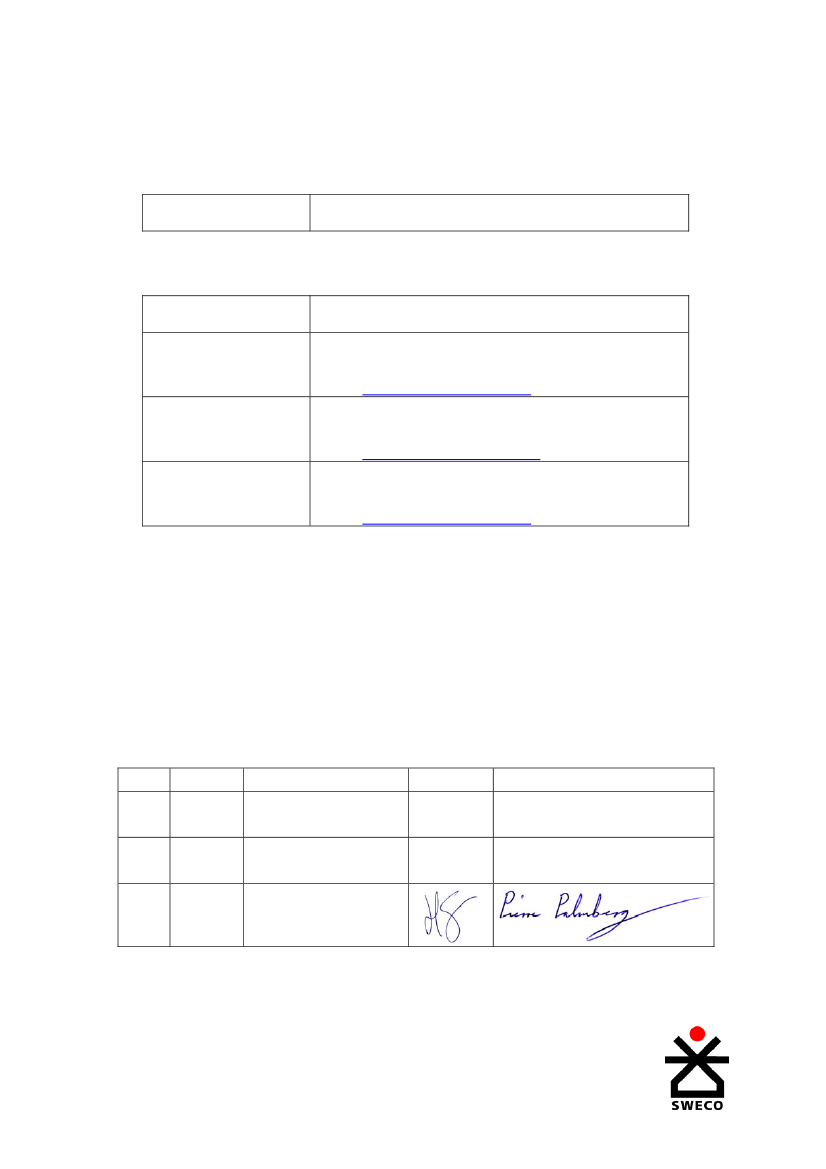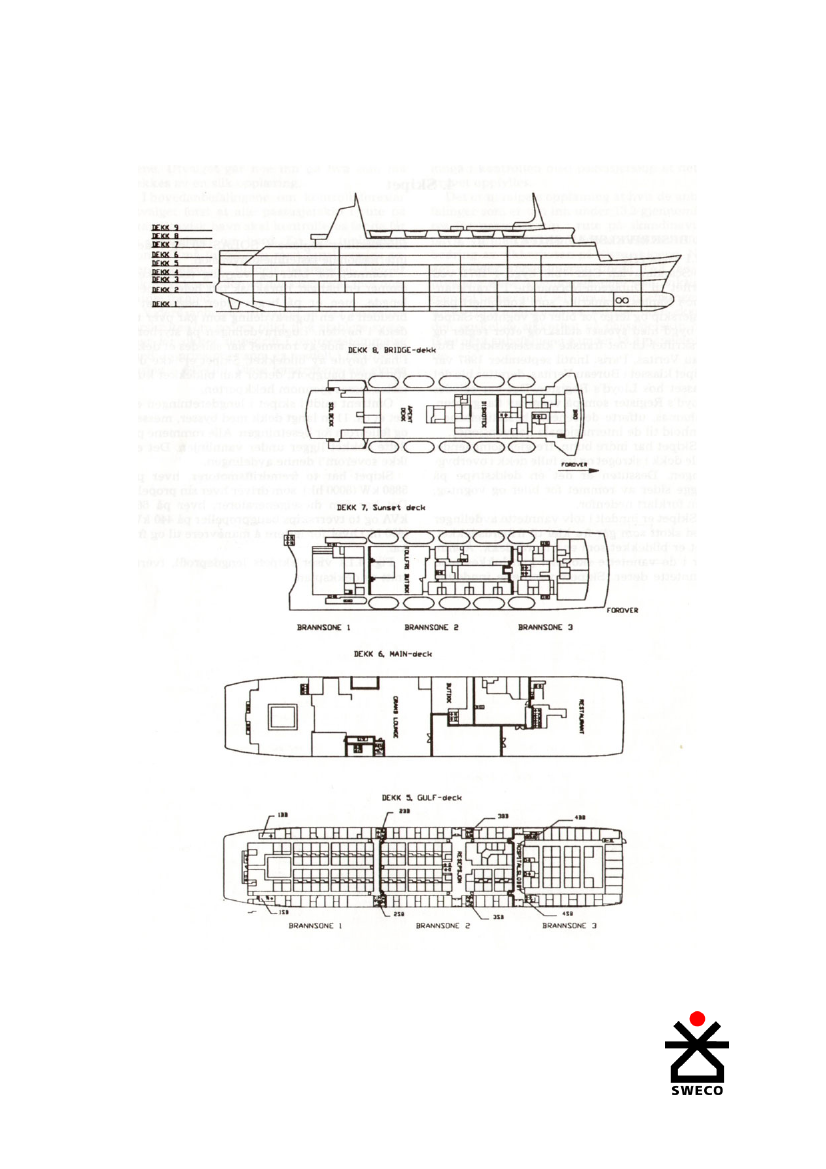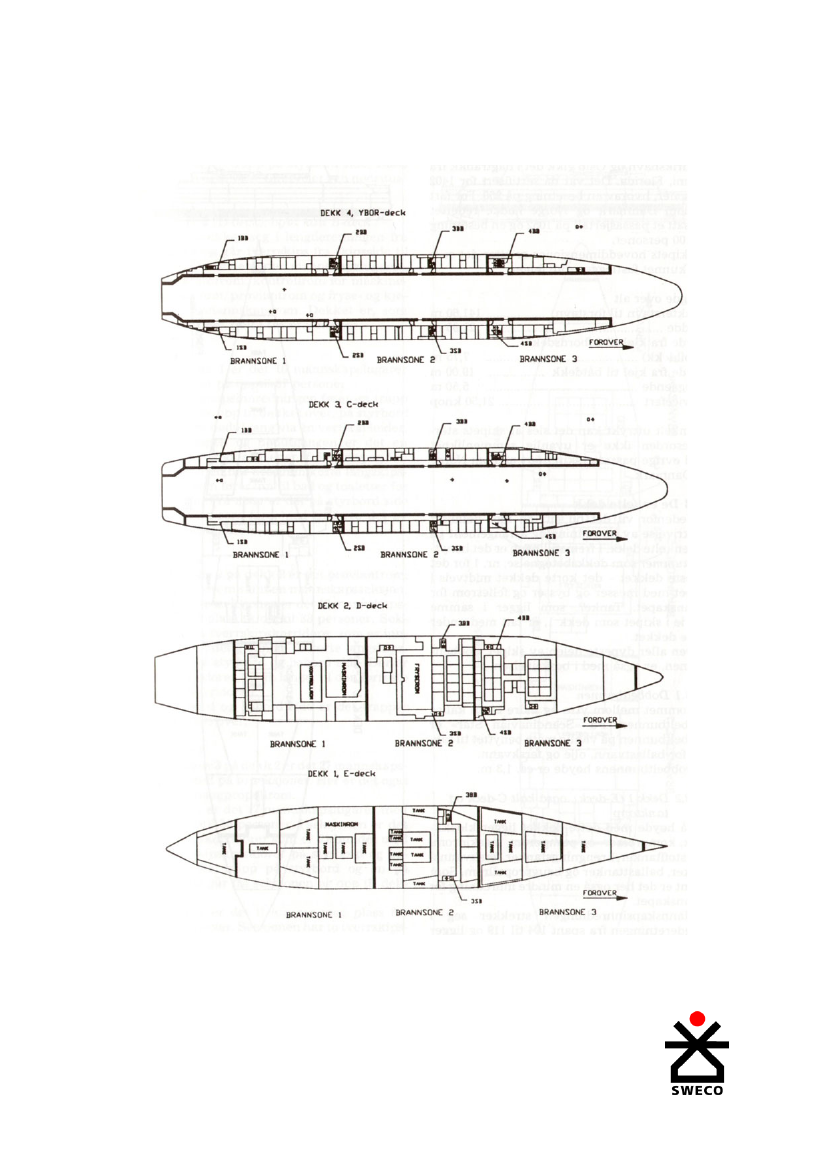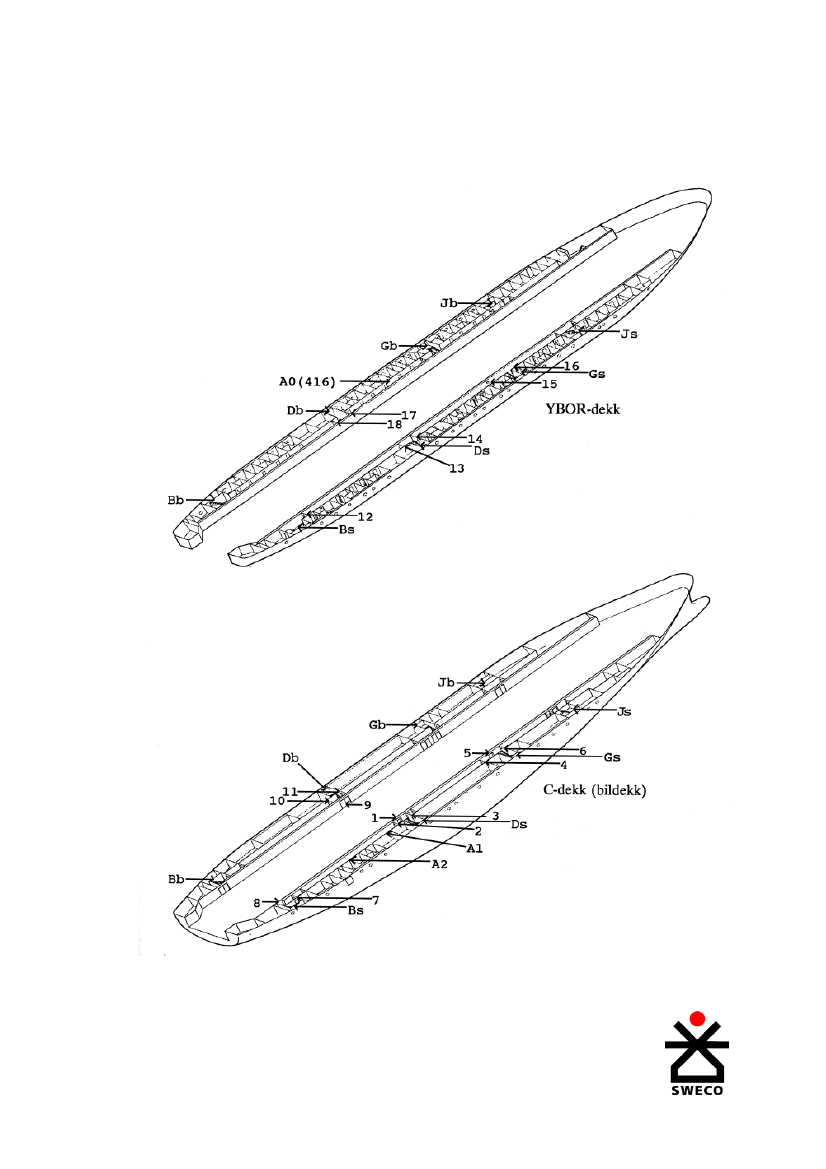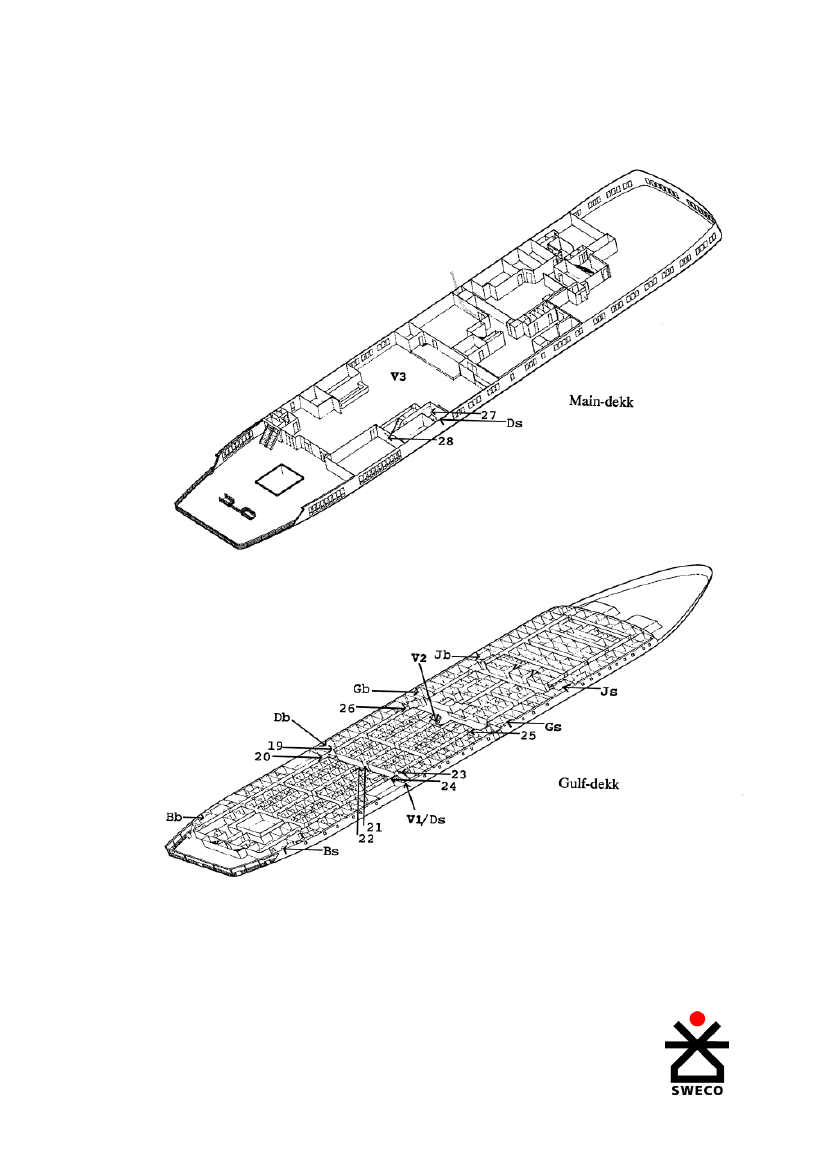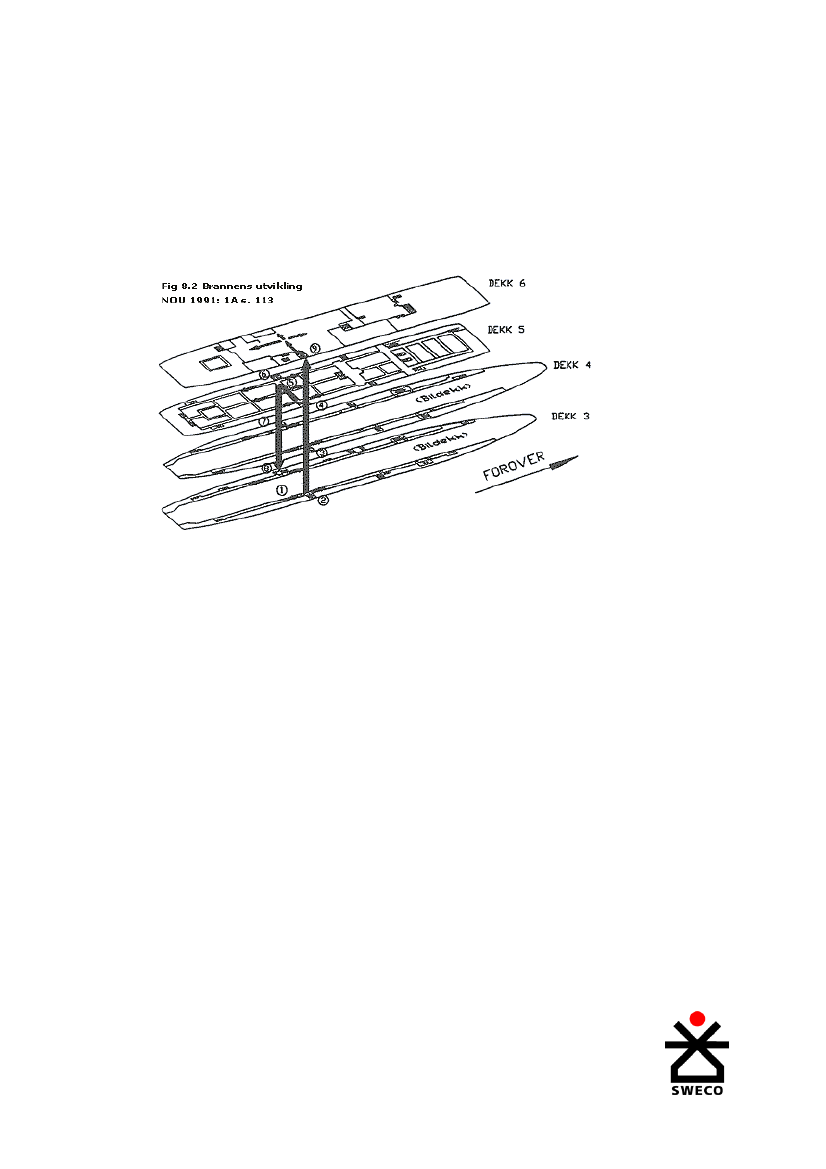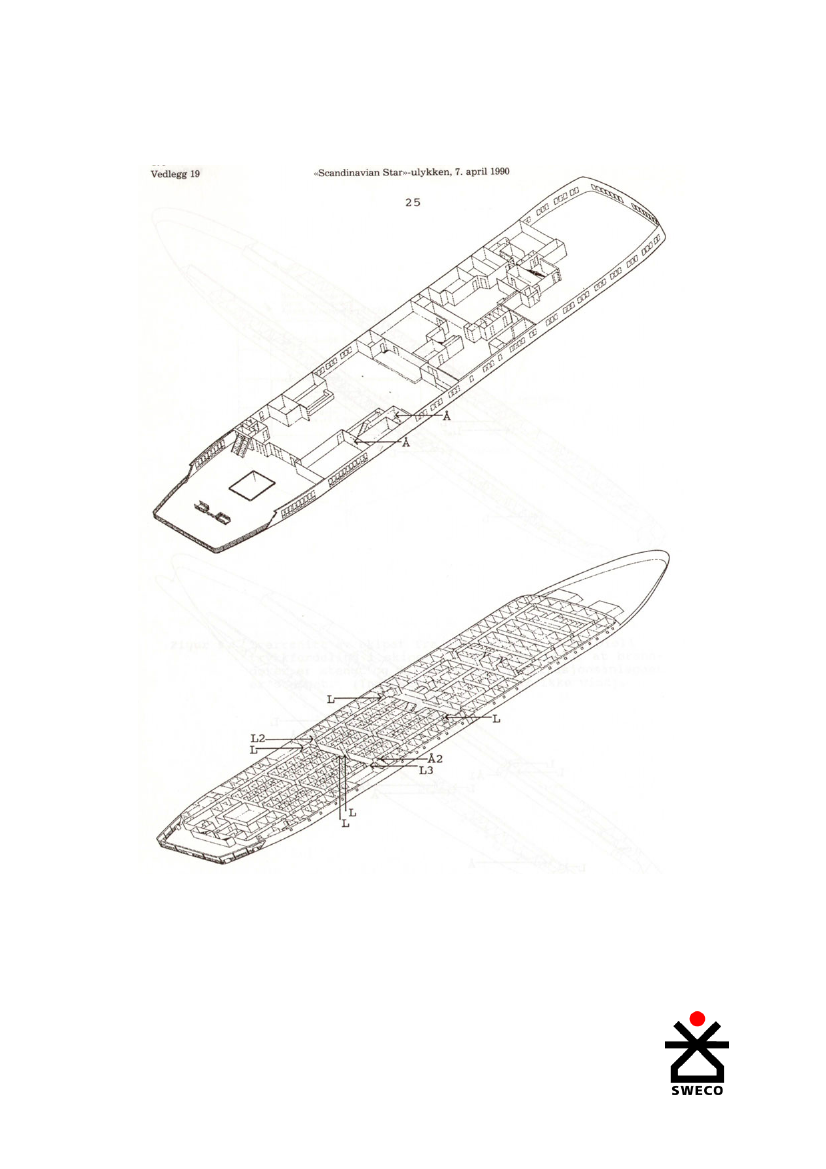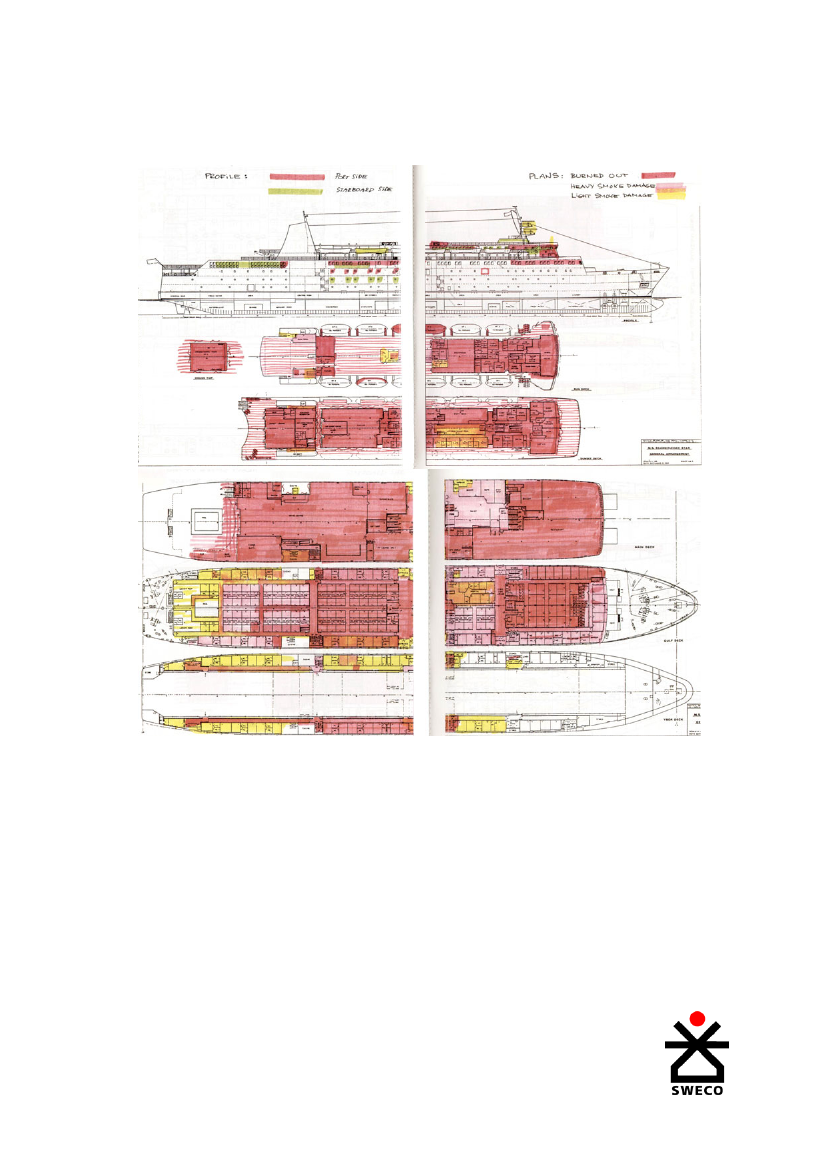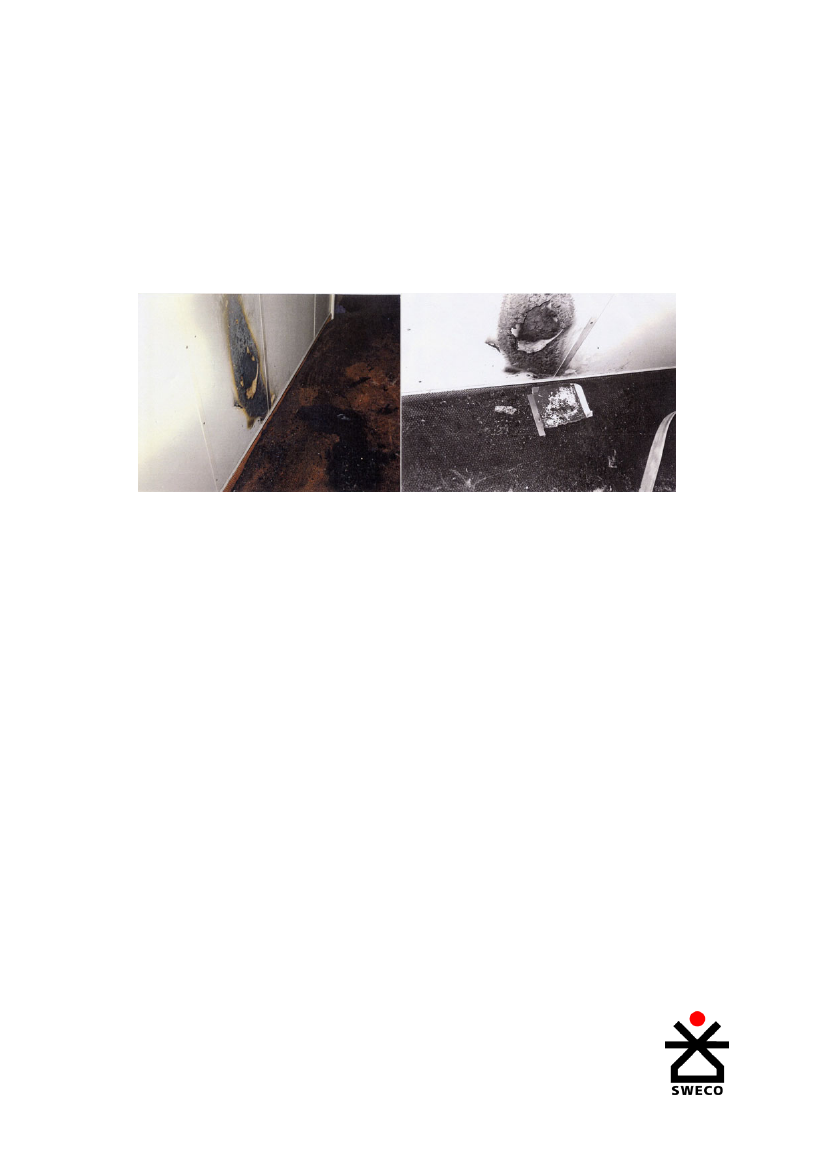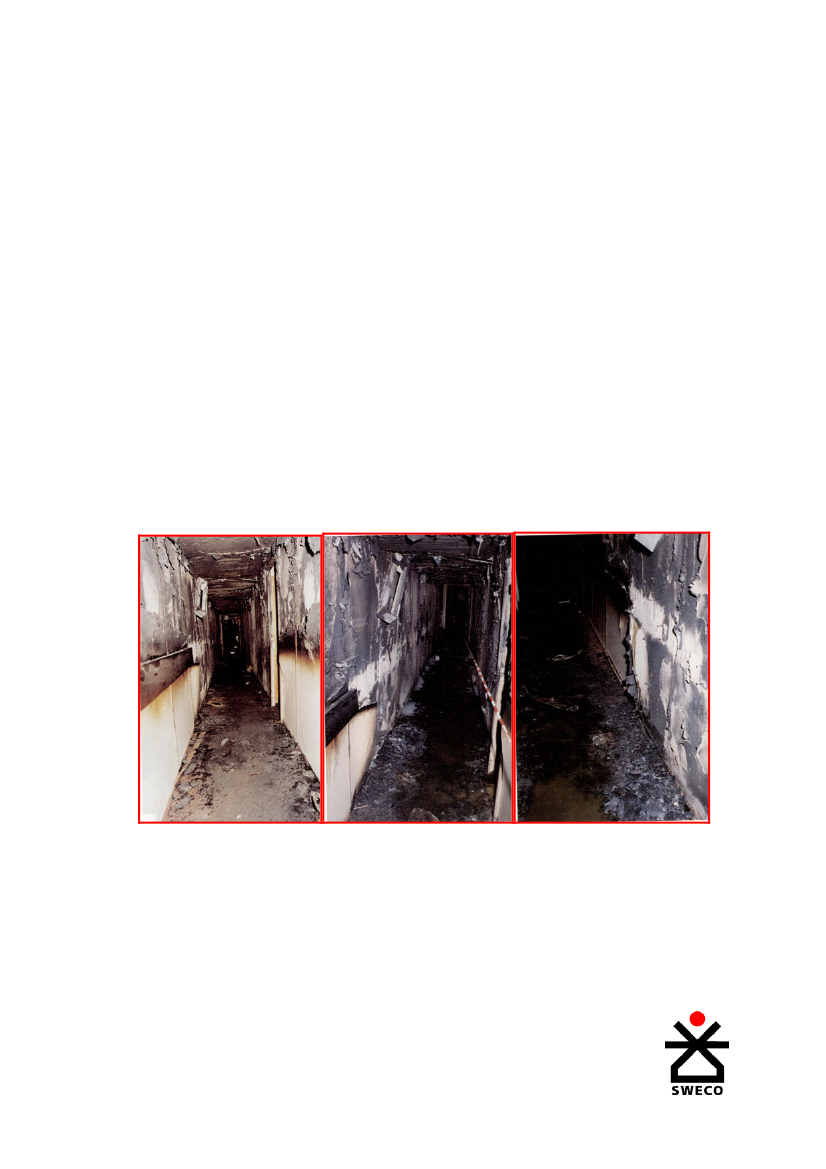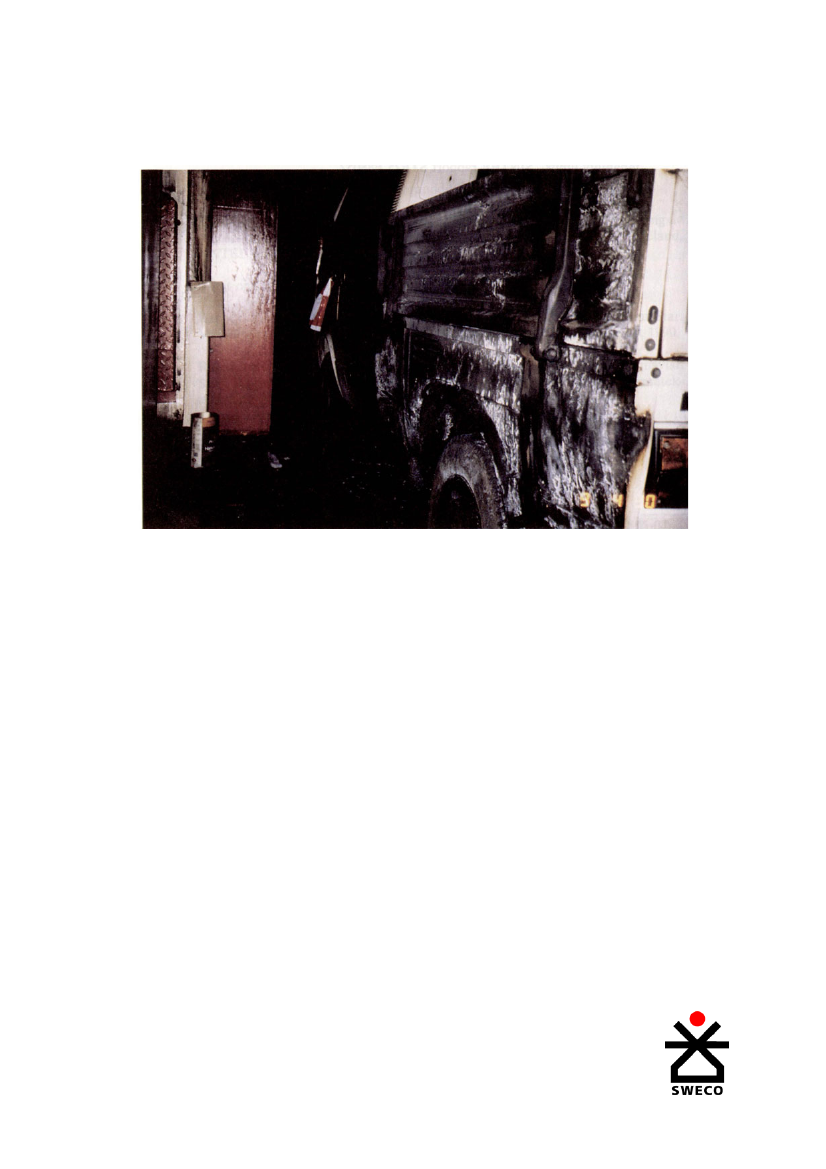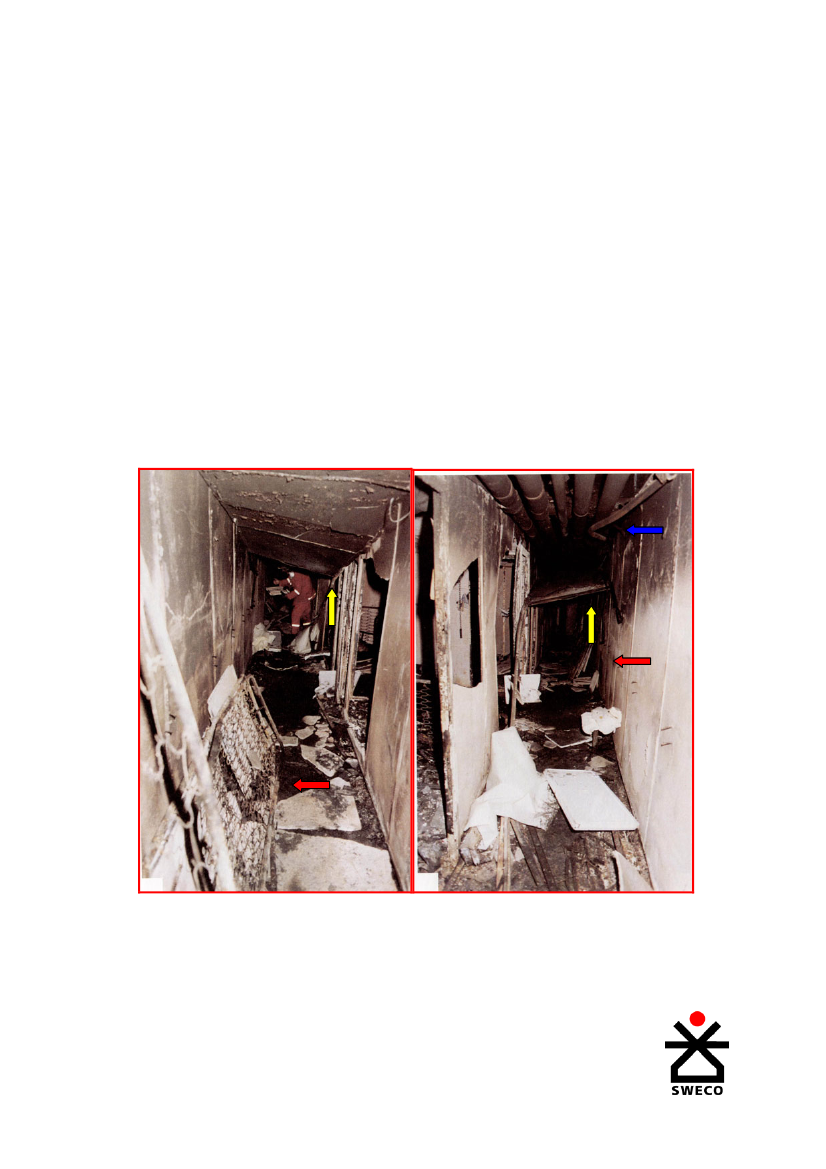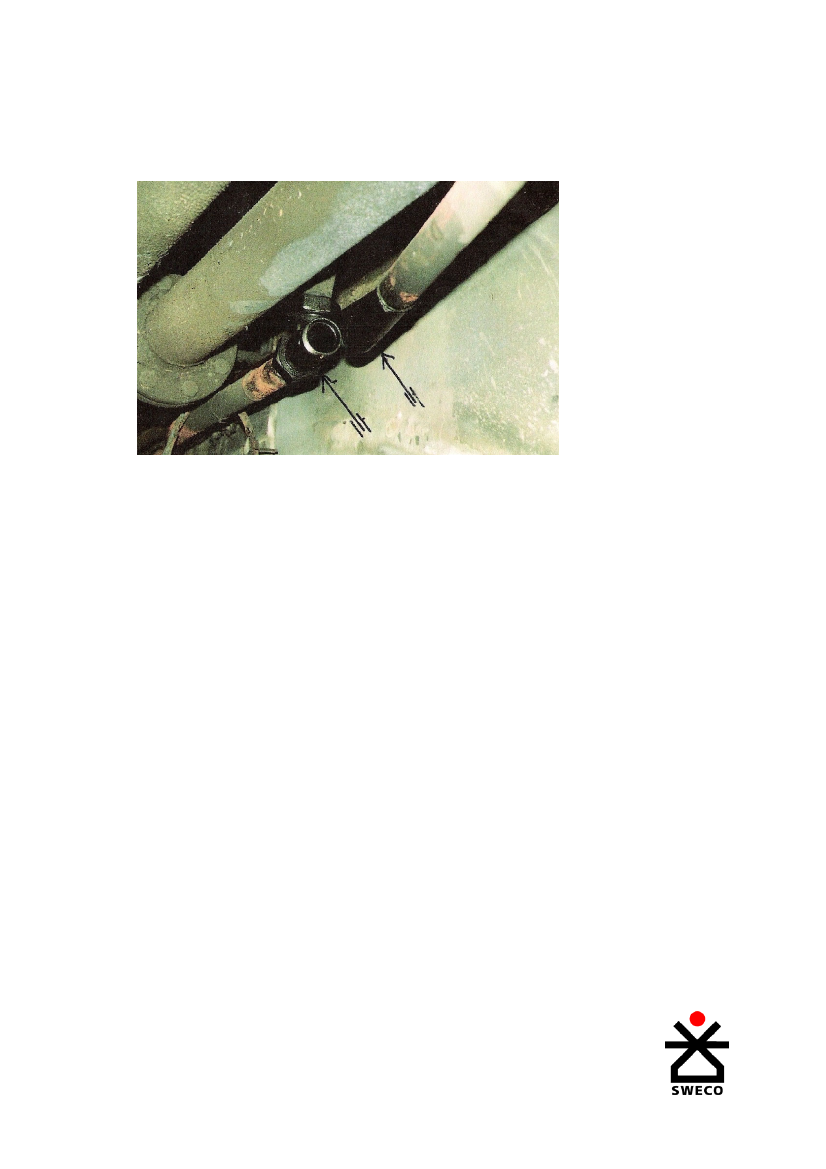Retsudvalget 2012-13
REU Alm.del Bilag 247
Offentligt
d
SCANDINAVIAN STARFire on board 070490-080490
FIRE INVESTIGATION
Preliminary studyMalmoe, Sweden, 2009-07-09SWECO Fire Protection Engineering and Risk Management
Pierre PalmbergFire Protection Engineer Lund UniversityHenrik GeorgssonFire Protection Engineer Lund UniversityProject No:4000455000
ra01s 2000-03-30
SWEC O F i re P ro t ect i o n En g i n eeri n gan d R i sk M an ag em entHans Michelsensgatan 2P.O. Box 286SE-201 22 Malmö, SwedenTelephone +4640 37 53 00Fax +46 40 15 43 47
Project 4000455000; PRPAp:\4337\4000455_prpa_scandinavianstar\21 brand\090709-preliminary fireinvestigation-scandinavian star.doc
SW EC O SYST EMS ABOrg.nr 556030-9733,residence StockholmPart of the SW ECO-groupwww.sweco.se
d
Document informationProject description:Scandinavian StarFire on board 070490-080490
Project no.:
4000455000Pierre PalmbergFire Protection Engineer Lund UniversityTelephone: +46 40 37 53 34E-mail:[email protected]Henrik GeorgssonFire Protection Engineer Lund UniversityTelephone: +46 40 37 53 38E-mail:[email protected]Pierre PalmbergFire Protection Engineer Lund UniversityTelephone: +46 40 37 53 34E-mail:[email protected]
Project Manager:
Project Administrator:
Quality Assuranceperformed by:
Edition---
Date2007-06-12
Document statusFire InvestigationPreliminary study (Swedish)Fire InvestigationPreliminary study (Swedish)Fire InvestigationPreliminary study (English)
Drawn up by
Quality assurance performed by
1
2008-04-29
2
2009-07-09
ra02s 1999-09-20
FIRE ON BOARD 070490-0804902009-07-09Scandinavian Star
Project 4000455000; PRPAp:\4337\4000455_prpa_scandinavian star\21 brand\090709-preliminary fire investigation-scandinavian star.doc
d
Contents123455.15.1.15.25.2.15.35.3.15.45.4.15.55.5.1678IntroductionFacts and documentationShip specificationsCourse of eventsAnalysis of the firesFire no. 1ConclusionFire no. 2 – The main fireConclusionFire no. 3ConclusionFire no. 4 and 5ConclusionFire no. 6ConclusionSummarizing discussion and conclusionsSuggested plan of action for further workList of figures and tables445101414141517181919192021222324
ra02s 1999-09-20
FIRE ON BOARD 070490-0804902009-07-09Scandinavian Star
Project 4000455000; PRPAp:\4337\4000455_prpa_scandinavian star\21 brand\090709-preliminary fire investigation-scandinavian star.doc
d
1
IntroductionThis fire investigation has been performed by Pierre Palmberg and Henrik Georgsson, FireProtection Engineers Lund University. Pierre Palmberg and Henrik Georgsson have performedthis investigation on their own initiative as independent experts within the field of fire and risktechnology. The project has been carried out as an internal project i.e. without compensationfrom any client. The object of the project has been to provide an adequate basis for decisionconcerning further investigation of the fire aboard the Scandinavian Star.This report is a developed and translated version of the preliminary study presented andofficially announced in 2006-08-15 by Pierre Palmberg and Henrik Georgsson. This report willundergo yet another thorough review, including assessment of the testimonies made, theconclusions drawn and further analysis of available photo and video material, this autumn(2009).
2
Facts and documentationThe following documentation has constituted the basis for this preliminary study:Norges Offentlige Utredninger (NOU): Scandinavian Star – ulykken, 7. april 1990, Hovedrapport NOU1991:1A and vedlegg NOU 1991:1B, Oslo 1991.SoS-rapport 1993:3: Branden på passagerarfärjan Scandinavian Star den 7 april 1990 (the NationalSwedish Board of Health and Welfare).Excerpts from SOLAS 60 as printed in the Swedish Maritime Administration’s statute book SJVFS1970:13.Testimony from Ingvar Brynfors – Gothenburg Rescue Service (Sweden), Fire Ground Commander forthe first rescue action aboard the Scandinavian Star.Testimony from Police Inspector Agne Knutsson – The Swedish Police Service, the first Police Officeraboard the Scandinavian Star after the fire.Post-mortem report concerning Erik Mörk Andersen denoted ”Likåbning SS 80/90 dato 100490” drawnup by expert M.D. Leif Jørgensen and Senior Physician Leif H Bostad, Rikshospitalet – RetsmedisinskInstitut, Oslo.Observer report from Scandinavian Star 1990-04-07 – 1990-04-09, Olle Wennström – Fire ProtectionEngineer (Sweden).I-R Logg (Rescue action log) Scandinavian Star 1990-04-07, Gothenburg Rescue Service (Sweden).
ra01s 2000-03-30
Fire on board 070490-0804902009-07-09Scandinavian Star
4 (24)Project 4000455000; PRPAp:\4337\4000455_prpa_scandinavian star\21 brand\090709-preliminary fire investigation-scandinavian star.doc
d
3
Ship specificationsIn the table below a short description of the ship and its equipment is presented.Technical specifications for M/S Scandinavian StarYear of productionNumber of decksLengthWidthHeight measured from keel tomain deck (car deck)Height measured from keel tosun deckDraughtCruising speedPassenger capacityNumber of passengers at thetime for the accident 1990-04-07Applied regulationsconcerning the constructionof the shipFire resistance class appliedto main fire sections (3)Ventilation systemOperation mode of theventilation system in case offire19718141,60 m21,9 m7,75 m
19,00 m5,50 m21,5 knots1152 passengers including 100 crew members
383 passengers and 99 crew members
SOLAS 60
A 60Mechanical supply/exhaust system with manuallyoperated fire dampers
Manual shutdown of fans and fire dampers
Table 1. Technical specifications for M/S Scandinavian Star.
ra01s 2000-03-30
Fire on board 070490-0804902009-07-09Scandinavian Star
5 (24)Project 4000455000; PRPAp:\4337\4000455_prpa_scandinavian star\21 brand\090709-preliminary fire investigation-scandinavian star.doc
d
ra01s 2000-03-30
Figure 1. Cross-sectional view of the ship along with plans for deck 5, 6, 7 and 8. Main firesections are represented by thick black lines.
Fire on board 070490-0804902009-07-09Scandinavian Star
6 (24)Project 4000455000; PRPAp:\4337\4000455_prpa_scandinavian star\21 brand\090709-preliminary fire investigation-scandinavian star.doc
d
Figure 2. Plans for deck 1, 2, 3 and 4. Main fire sections are represented by thick black lines.ra01s 2000-03-30
Fire on board 070490-0804902009-07-09Scandinavian Star
7 (24)Project 4000455000; PRPAp:\4337\4000455_prpa_scandinavian star\21 brand\090709-preliminary fire investigation-scandinavian star.doc
d
ra01s 2000-03-30
Figure 3. Overview showing door and staircase notations for Ybor deck (deck 4) and C deck(deck 3).
Fire on board 070490-0804902009-07-09Scandinavian Star
8 (24)Project 4000455000; PRPAp:\4337\4000455_prpa_scandinavian star\21 brand\090709-preliminary fire investigation-scandinavian star.doc
d
Figure 4. Overview showing door and staircase notations for Main deck (deck 6) and Gulf deck(deck 5).
ra01s 2000-03-30
Fire on board 070490-0804902009-07-09Scandinavian Star
9 (24)Project 4000455000; PRPAp:\4337\4000455_prpa_scandinavian star\21 brand\090709-preliminary fire investigation-scandinavian star.doc
d
4
Course of eventsThe course of events during the first part of the fire on the 7thof April 1990 is described in Figure5 below. These events represent what was later on denoted as “The Main fire”. In the followingsections of this report these events are denoted as “Fire No. 2”.
Fire spread timeline for fire no. 2(positions are denoted with numbers)1. The fire starts here at approx. 02:00 (hh:mm). 2-8 minutes later the heat release ratereaches 200 kW. This point in time is set to the starting point for the catastrophic fire.2. The fire is spreading rapidly to this staircase and further upwards.3. The smoke reaches deck 3 approx. 1 minute after the fire start and spreads to theadjacent corridors ahead and astern the staircase. The fire door ahead the staircaseremains open.4. The smoke reaches deck 5 after approx. 2-3 minutes and starts to spread into theadjacent corridors.5. The fire spreads from starboard to port through this crossing corridor.6. On the port side the fire spreads downwards through the staircase.7. A smaller amount of smoke spreads to the corridors on the port side of deck 4. Allpassengers in this section were evacuated.8. The fire spreads down to deck 3 where the fire door leading to car deck is in openposition.’9. The fire also spreads into the restaurant section on deck 6 through an open fire door onthe top floor of the staircase.Figure 5. The spread of the main fire (Fire No. 2) throughout the ship. Note that the descriptionof the course of events is a direct translation of description as printed in the NOU 1991:1Areport.ra01s 2000-03-30
Fire on board 070490-0804902009-07-09Scandinavian Star
10 (24)Project 4000455000; PRPAp:\4337\4000455_prpa_scandinavian star\21 brand\090709-preliminary fire investigation-scandinavian star.doc
d
Figure 6. Drawing that shows closed and open fire doors on deck 3 (lower drawing) and deck 4(upper drawing) which allows fire to spread as described in Figure 5. ”Å” denotes an open doorand ”L” denotes a closed door. ”Å1” denotes that the door is almost fully open and ”L1” denotesthat there is a leakage caused by either poor sealing or a slit between the door and thedoorframe.
ra01s 2000-03-30
Fire on board 070490-0804902009-07-09Scandinavian Star
11 (24)Project 4000455000; PRPAp:\4337\4000455_prpa_scandinavian star\21 brand\090709-preliminary fire investigation-scandinavian star.doc
d
ra01s 2000-03-30
Figure 7. Drawing that shows closed and open fire doors on deck 5 (lower drawing) and deck 6(upper drawing) which allows fire to spread as described in Figure 5. ”Å” denotes an open doorand ”L” denotes a closed door. ”Å1” denotes that the door is almost fully open and ”L1” denotesthat there is a leakage caused by either poor sealing or a slit between the door and thedoorframe ”Å2” denotes that the door has been open for a period of time during the fire. ”L2”denotes either that the leaking conditions for the door is uncertain or that the door has beenshut for a period of time during the fire. “L3” denotes either that the leaking conditions for thedoor is uncertain or that the door has been shut during the starting phase of the fire.
Fire on board 070490-0804902009-07-09Scandinavian Star
12 (24)Project 4000455000; PRPAp:\4337\4000455_prpa_scandinavian star\21 brand\090709-preliminary fire investigation-scandinavian star.doc
d
Figure 8. Drawings that show reported damages due to fire on each deck respectively, see alsochapter 5.5.1.
ra01s 2000-03-30
Fire on board 070490-0804902009-07-09Scandinavian Star
13 (24)Project 4000455000; PRPAp:\4337\4000455_prpa_scandinavian star\21 brand\090709-preliminary fire investigation-scandinavian star.doc
d
Analysis of the firesFire no. 1
Fire no. 1 started around 01.55 am on the 7thof April 1990 outside cabin 416 on deck 4(Ybor/Caribbean deck). This fire was discovered early and it was at that time of small magnitudeand could therefore easily be put out by passengers and crew members.
Figure 9. Pictures showing the starting location for fire no. 1. The picture on the right includesthe piece of cardboard that was used to create a pilot flame.5.1.1ConclusionFire no. 1 was of no importance for the following chain of events. It is also clear that fire no. 1was not accidental but was an attempted arson, see Figure 9. According to SOLAS 60 thecaptain is obligated to activate the evacuation alarm, leading to a total evacuation of the ship,when a fire is detected on board. If the evacuation alarm had been activated at this point it ishighly plausible that the number of casualties due to the subsequent fire (no. 2) would havebeen much lower.
ra01s 2000-03-30
Fire on board 070490-0804902009-07-09Scandinavian Star
14 (24)Project 4000455000; PRPAp:\4337\4000455_prpa_scandinavian star\21 brand\090709-preliminary fire investigation-scandinavian star.doc
d
Fire no. 2 – The main fire
Fire no. 2 started around 02.00 am on the 7thof April 1990 outside cabin 219 on deck 3 (Cdeck/A deck). This fire is officially denoted as “The main fire”. No fire extinguishing measuresare initiated by the captain at this point. The fire accelerates rapidly upwards throughout theship as described in Figure 5 above.According to eyewitness testimonies, door no. 5 (A 60) between car deck (deck 3) and staircaseGs(3 SB) on the starboard side of the ship was open about 10-15 cm and that door no. 9 (A 60)between car deck (deck 3) and staircase Db(2 BB) on the port side of the ship was almostcompletely open (approx. 1 m) during the main fire, see Figure 3 and Figure 11.Eye witnesses state that the ventilation system was running normally during the starting phaseof fire no. 2 and that the fire at this time was to be considered as normal. Eye witnesses alsostate that the ventilation system, after 10-15 minutes, was forced towards maximum flow whichresulted in an acceleration of the fire into a scenario which is to be considered as unnatural. Theincreased ventilation flow drives the fire downwards through staircase Db(2 BB) to car deck(deck 3) up to a point in time where the ventilation system is shut down completely. The factthat the ventilation system was shut down lead to a change of pressure conditions in thepassenger cabins, from overpressure to underpressure. This change of pressure conditionsdrives highly toxic smoke into the cabins. After about 10 minutes critical conditions in terms ofCO (carbon monoxide) and HCN (hydrogen cyanide) concentrations are a fact.Figure 10. Three photographs showing damages in the hallway on deck 3, on starboard side ofthe ship, astern of staircase Ds(2 SB). The door opening, visible to the right in the picture on theleft, leads in to cabin 219. Fire no. 2 (the main fire) was started in this hallway.
ra01s 2000-03-30
Fire on board 070490-0804902009-07-09Scandinavian Star
15 (24)Project 4000455000; PRPAp:\4337\4000455_prpa_scandinavian star\21 brand\090709-preliminary fire investigation-scandinavian star.doc
d
Figure 11. Photograph showing a car damaged by fire. The car was parked just nearby theopen sliding door no. 9 (A 60), see Figure 3, on the car deck. The air velocity trough this specificfire door opening has been measured to 20 m/s (during a full scale test on board a sister vessel)without the thermal effects from a fire. Note that this velocity refers to cold air. At a smoketemperature of 600�C the velocity increases by approximately a factor 3. This indicates thelarge effect that the ventilation system would have on the main fire.According to eyewitness testimonies a flashover occurs, in the rear part of the restaurant/loungearea on deck 6 (main deck), approximately 30-40 minutes after the fire started. During thisphase the fire consumes all combustible material in this part of the ship.When the fire brigade arrives, approximately 3,5 hours after the fire started (approx. 5.30 am),a fully developed fire is in progress astern in the ship. However, at this time, the parts ahead inthe ship on deck 6, including kitchen and restaurant, along with the parts ahead on deck 7 and8, are not affected by the fire. Around 11.30 a.m. permanent smoke ventilation of the stern andmiddle parts of deck 6 is established, by breaking windows and the use of side openings in thereception lobby on deck 5.
ra01s 2000-03-30
Fire on board 070490-0804902009-07-09Scandinavian Star
16 (24)Project 4000455000; PRPAp:\4337\4000455_prpa_scandinavian star\21 brand\090709-preliminary fire investigation-scandinavian star.doc
d
5.2.1
ConclusionAccording to eyewitness testimony, the ventilation systems are running as normal when fire no.2 starts. After 10-15 minutes, the ventilation is forced, using the exhaust fans for car deck (deck3/C), towards maximum flow capacity, resulting in the movement of hot smoke towards thestrategically open fire door.Full scale tests carried out by SINTEF aboard Scandinavian Star’s sister ship “Jupiter” shows airspeed at normal room temperature of approx. 20 m/s across sliding door no. 9 (A 60) betweencar deck (deck 3) and staircase Db(2 BB) on the port side. In a fire situation, this air speed hasprobably been approx. 60 m/s caused by the fact that the invoked gas mix sucked down troughthe staircase had a temperature of at least 500-600�C and thus had a density of approx. 1/3 ofthe density of air at room temperature.Given that a number of fire doors, see Figure 6, were left opened along with that the ventilationsystem at first was operating normally and then was controlled so that all fans on car deckevacuated air, close to ideal conditions for rapid fire spread were given. This is also the onlypossible operation for the ventilation system that allows smoke to be sucked down trough Db(2BB) in opposite direction of the normal flow direction.To create these ideal conditions for rapid fire spread requires extensive knowledge regardingfire dynamics, the ship and its technical systems, the location of the control devices as well asthe functionality of all these systems is needed. Furthermore the arsonist/arsonists must haveaccess to a number of locked rooms to be able to control the systems in question.thFire no. 2 was started in fire zone 1 on deck 3 at approx. 02.00 on April 7 1990. Fire no. 2resulted in the death of 159 persons and extensive damage to the ship in fire zone no. 1 and 2.
ra01s 2000-03-30
Fire on board 070490-0804902009-07-09Scandinavian Star
17 (24)Project 4000455000; PRPAp:\4337\4000455_prpa_scandinavian star\21 brand\090709-preliminary fire investigation-scandinavian star.doc
d
Fire no. 3
Eyewitness testimonies states that fire no. 3 was started at approx. 11.00-12.00 am on the 7thofApril 1990 in the 300-section/fire zone 2 on deck 4 (Ybor/Caribbean deck). The fire started, andwas most likely fuelled by hydraulic oil spraying out of the hydraulic system at elevated pressureand was ignited. Available documentation indicates that the hydraulic oil most likely has beenignited by using a bed as a pilot flame, see Figure 12. This hydraulic system is not intended tobe running when the ship is at sea since it only controls the vehicle lift on car deck.Manoeuvring the hydraulic pump can only be done using the controls located in a separate andlocked room on car deck.The leaking hydraulic pipe (indicated by a blue arrow in the photograph below on the right) issharply bent horizontally towards the bulkhead (cabin wall). The other pipes, set in the sameceiling section as the leaking hydraulic pipe, are unaffected by the fire.Note that only some parts of the ceiling section (indicated by a yellow arrow) that, prior to thefire, was covering the entire pipe zone has collapsed despite the fact that the entire corridor wasinvolved in this fire which indicates that it was destroyed by hand before the fire.ra01s 2000-03-30
Figure 12. The two photographs show the location for the start of fire no. 3 (the hydraulicfire).On these photographs, the bed (indicated by a red arrow) that most likely has been used toignite the hydraulic oil is visible. The blue arrow indicates the hydraulic pipe in question. Theother pipes, set in the same ceiling section as the leaking hydraulic pipe, are unaffected by thefire. Note that only some parts of the ceiling section (indicated by a yellow arrow) that, prior tothe fire, was covering the entire pipe zone has collapsed despite the fact that the entire corridorwas involved in this fire which indicates that it was destroyed by hand before the fire.
Fire on board 070490-0804902009-07-09Scandinavian Star
18 (24)Project 4000455000; PRPAp:\4337\4000455_prpa_scandinavian star\21 brand\090709-preliminary fire investigation-scandinavian star.doc
d
Figure 13. Photograph showing the connection closest to the horizontal bend in the hydraulicpipe in question.5.3.1ConclusionA hydraulic pipe is constructed and mounted in bulkheads to withstand the very high pressuresthey are designed for during normal operation. A hydraulic pipe like that, so heavily affected byfire to the extent that it starts leaking oil in a connection, should be bent down on a very longsection (notably longer than the distance between the true fixation points since the fixationsmost likely can´t withstand the fire any longer than the hydraulic pipe and it´s connections) andin a soft arc vertically down towards the cabin sole.The look of the hydraulic pipe hence indicates that it most likely has been bent to its currentposition by mechanical damage carried out by human hand and that fire 3 thus most likely wasarson. Fire no. 3 resulted in extensive damage on the ship in fire zone 2.Available documentation regarding fire damage on the ship along with the fire scenariocalculations carried out by SINTEF indicates that this fire didn´t break through the firecompartment division (A 60) towards fire zone 3, see also Figure 8 and chapter 5.6.1.
Fire no. 4 and 5
These two arsons was attempted in or close by staircases Bs(1 SB) and BB(1 BB) respectivelyin the stern part of the ship on deck 3. The starting times for these fires are unknown but it ismost likely that they were started quite some time before the ship reached Lysekil. The effectsof these fires are uncertain but were most likely moderate.5.4.1
ConclusionFire no. 4 and 5 were attempted arsons but have no documented significance on the furthercourse of events.
ra01s 2000-03-30
Fire on board 070490-0804902009-07-09Scandinavian Star
19 (24)Project 4000455000; PRPAp:\4337\4000455_prpa_scandinavian star\21 brand\090709-preliminary fire investigation-scandinavian star.doc
d
Fire no. 6
The fire in the stern parts of the decks 6, 7 and 8 (part of fire no. 2, fire zone 2) is reported, byththe rescue services personnel, to be put out at approx. 11.30 am on April 7 1990.The official report, regarding the fire damages on the ship (see Figure 8) shows that the frontparts of the middle fire zone (zone 2) on deck 5, is, to some extent, only lightly smoke damaged,and in other parts heavily smoke damaged and that the kitchen part on deck 6 (separate firecompartment in fire class A 60) is heavily smoke damaged. This clearly indicates that the fire(fire no. 2) wasn´t completely developed in these parts.Fire no. 6 starts in fire zone 3 some time after the ship has arrived at Lysekil at 21.17 pm on theth7 of April 1990. Fire no.6 involves the front parts of decks 5, 6, 7, and 8. Note that the firstgroup from the rescue services was lowered from helicopter on to the bow on deck 7 andestablished command centre in the front, upper part of the ship in connection with the initiationof the fire rescue operations (approximately 3,5 hours after the start of fire no. 2). This clearlyindicates that these parts of the ship were not involved in fire no. 2. The fire wasn´t extinguishedthuntil on the evening of April 8 1990.Figure 14. Photograph showing the restaurant in the front part of deck 6. The heavy firedamages are most likely the effects of fire no. 6.
ra01s 2000-03-30
Fire on board 070490-0804902009-07-09Scandinavian Star
20 (24)Project 4000455000; PRPAp:\4337\4000455_prpa_scandinavian star\21 brand\090709-preliminary fire investigation-scandinavian star.doc
d
5.5.1
ConclusionAvailable documentation regarding the fire damages on the ship indicates that it is most unlikelythat the documented damages in fire zone 3 is an effect of natural fire spread from fire zone 2(fires no. 2 and 3). The fact that the upper front part of the ship was used as a command centrefor the rescue operation, also shows that this part of the ship was unaffected by the fire beforethe ship had arrived at Lysekil. This is further confirmed by the fact that permanent smokeventilation of the parts affected by fire in the middle and stern parts of the ship was establishedalready around 11.30 (see also chapter 5.2).The heavy smoke damages in the kitchen are most likely the consequence of the poor integrityof the fire door (A 60) between the kitchen and staircase (between the reception on deck 5 andstir lounge on deck 6) and hence there has been a substantial leakage of smoke. The fact thatthe fire in fire zone 2, on deck 6, astern of the kitchen, was relatively easily extinguishedprobably depends on the flashover earlier in the fire scenario (fire no. 2) which consumed themajor part of the combustible material in this part of the ship. During this fire rescue operation,the rescue service clears the windows on deck 6 and opens up the side openings on deck 5,thus securing permanent smoke ventilation in this part in order to prevent flashover and hencefacilitating further rescue operations and preventing fire spread to fire zone 3.The fact that the stairs between the reception on deck 5 and the stair lounge on deck 6 wasopen has also contributed to the much less extensive fire damages in the front part of fire zone2 on deck 5. This, along with the rescue operations mentioned above shows that it is highlyunlikely that the documented damages in fire zone 3 are the effects of natural fire spread fromfire zone 2.Fire no. 6, hence was most likely arson, set in fire zone 3 on deck 5 when the ship had arrivedat Lysekil. Fire no. 6 resulted in extensive damage on the ship in fire zone 3.
ra01s 2000-03-30
Fire on board 070490-0804902009-07-09Scandinavian Star
21 (24)Project 4000455000; PRPAp:\4337\4000455_prpa_scandinavian star\21 brand\090709-preliminary fire investigation-scandinavian star.doc
d
6
Summarizing discussion and conclusionsThe conclusions of this preliminary study are summarized below along with added comments.1. Fire no. 1 has no significance on the further course of events. Fire no.1 was anattempted arson. According to SOLAS 60, the captain should at this point haveactivated the evacuation alarm and evacuated all persons aboard to outside decks. Ifthis had been done the number of casualties would most likely have been considerablylower.th2. Fire no. 2 started in fire zone 1 on deck 3 at approximately 02.00 on April 7 1990. Fireno. 2 resulted in the loss of 159 human lives along with extensive damage on the ship infire zones 1 and 2.
3. The current state of the hydraulic pipe indicates that it most likely has been bent asshown by mechanical force from human hand and that fire no. 3, hence was arson. Fireno. 3 resulted in extensive damage on the ship in fire zone 2.4. Fire no. 4 and 5 were attempted arsons but have no documented significance on thefurther course of events.5. Fire no. 6 was most likely arson set in fire zone 3 on deck 5 when the ship had arrivedat Lysekil. Fire no. 6 resulted in extensive damage in fire zone 3.6. The post-mortem report shows that the suspected arsonist Erik Mörk Andersen died inthe main fire (fire no. 2) and consequently it is impossible that he started thesubsequent fires. By logic this also makes it highly unlikely that he started the first twofires (fires no. 1 and 2).7. The public investigation made up till now (Norges Offentlige Utredninger (NOU):Scandinavian Star – ulykken, 7. april 1990, Hovedrapport NOU 1991:1A samt vedleggNOU 1991:1B, Oslo 1991) only considers events covering the main fire (fire no. 2). Thispreliminary study indicates that it is of utter importance to investigate the full chain ofevents (fire no 1 trough 6) completely in order to initiate a renewed crime investigationetc. The purpose of such further investigation is primarily to clarify the following:The effect of the ventilation system on the fire scenarios.To what extent fire impact on hydraulic pipes can lead to a deformation of the type,with resulting leakage, that occurred during fire no. 3.To what extent fire no. 6 might be the result of natural fire spread between firezones 2 and 3, alternatively show that this fire definitely was arson.If there is a natural explanation to the fact that the hydraulic system was operating.Why the other pipes in the same piping section as the damaged hydraulic pipeweren´t damaged although they obviously were subjected to an equal fire exposure.Why the ship had a list of 7-9 degrees approximately 30 minutes after the start offire no. 2 since no water had been used for fire fighting operations or sprinklersystems nor were there any leaks in the hull.Other related events that hasn´t been investigated.
ra01s 2000-03-30
Fire on board 070490-0804902009-07-09Scandinavian Star
22 (24)Project 4000455000; PRPAp:\4337\4000455_prpa_scandinavian star\21 brand\090709-preliminary fire investigation-scandinavian star.doc
d
7
Suggested plan of action for further workBelow a general plan of action for further work is suggested.1. Fire scenario calculations with a proper CFD-model regarding all fire scenarios. Theproject organisation for this should consist of two separate work groups with all thenecessary competence in the field of fire engineering, performing and auditing the workdone respectively. The purpose of these calculations is to scientifically secure a timelinefor all fire scenarios and their consequences.2. Full scale tests regarding fire impact on a section of hydraulic pipes (as a complementto the CFD-calculations when necessary). The project organisation for this shouldconsist of two separate work groups with all the necessary competence in the field offire engineering, performing and auditing the work done respectively.3. Full scale tests regarding the effect of the ventilation system on the fire scenarios (as acomplement to the CFD-calculations when necessary). The project organisation for thisshould consist of two separate work groups with all the necessary competence in thefield of fire engineering, performing and auditing the work done respectively.4. When results from the tests and calculations above are present a group consisting ofexperts in the field of fire engineering, with the aim of supporting police and otheraffected authorities in the further work, should be designated and given a completeassignment specification without limiting factors that might compromise the result of theinvestigation.5. The final report should be presented in full for all affected governments and affectedauthorities as well as the public in the respective countries.6. The final report should be publicly published in full along with a popular (short) version.
ra01s 2000-03-30
Fire on board 070490-0804902009-07-09Scandinavian Star
23 (24)Project 4000455000; PRPAp:\4337\4000455_prpa_scandinavian star\21 brand\090709-preliminary fire investigation-scandinavian star.doc
d
8
List of figures and tablesFigure 1. Cross-sectional view of the ship along with plans for deck 5, 6, 7 and 8. Main firesections are represented by thick black lines. ............................................................................6Figure 2. Plans for deck 1, 2, 3 and 4. Main fire sections are represented by thick black lines....7Figure 3. Overview showing door and staircase notations for Ybor deck (deck 4) and C deck(deck 3).....................................................................................................................................8Figure 4. Overview showing door and staircase notations for Main deck (deck 6) and Gulf deck(deck 5).....................................................................................................................................9Figure 5. The spread of the main fire (Fire No. 2) throughout the ship. Note that the descriptionof the course of events is a direct translation of description as printed in the NOU 1991:1Areport. .....................................................................................................................................10Figure 6. Drawing that shows closed and open fire doors on deck 3 (lower drawing) and deck 4(upper drawing) which allows fire to spread as described in Figure 5. ”Å” denotes an open doorand ”L” denotes a closed door. ”Å1” denotes that the door is almost fully open and ”L1” denotesthat there is a leakage caused by either poor sealing or a slit between the door and thedoorframe. ..............................................................................................................................11Figure 7. Drawing that shows closed and open fire doors on deck 5 (lower drawing) and deck 6(upper drawing) which allows fire to spread as described in Figure 5. ”Å” denotes an open doorand ”L” denotes a closed door. ”Å1” denotes that the door is almost fully open and ”L1” denotesthat there is a leakage caused by either poor sealing or a slit between the door and thedoorframe ”Å2” denotes that the door has been open for a period of time during the fire. ”L2”denotes either that the leaking conditions for the door is uncertain or that the door has beenshut for a period of time during the fire. “L3” denotes either that the leaking conditions for thedoor is uncertain or that the door has been shut during the starting phase of the fire................12Figure 8. Drawings that show reported damages due to fire on each deck respectively, see alsochapter 5.6.1...........................................................................................................................13Figure 9. Pictures showing the starting location for fire no. 1. The picture on the right includesthe piece of cardboard that was used to create a pilot flame. ...................................................14Figure 10. Three photographs showing damages in the hallway on deck 3, on starboard side ofthe ship, astern of staircase Ds(2 SB). The door opening, visible to the right in the picture on theleft, leads in to cabin 219. Fire no. 2 (the main fire) was started in this hallway. .......................15Figure 11. Photograph showing a car damaged by fire. The car was parked just nearby theopen sliding door no. 9 (A 60), see Figure 3, on the car deck. The air velocity trough this specificfire door opening has been measured to 20 m/s (during a full scale test on board a sister vessel)without the thermal effects from a fire. Note that this velocity refers to cold air. At a smoketemperature of 600�C the velocity increases by approximately a factor 3. This indicates thelarge effect that the ventilation system would have on the main fire. ........................................16Figure 12. The two photographs show the location for the start of fire no. 3 (the hydraulicfire).On these photographs, the bed (indicated by a red arrow) that most likely has been used toignite the hydraulic oil is visible. The blue arrow indicates the hydraulic pipe in question. Theother pipes, set in the same ceiling section as the leaking hydraulic pipe, are unaffected by thefire. Note that only some parts of the ceiling section (indicated by a yellow arrow) that, prior tothe fire, was covering the entire pipe zone has collapsed despite the fact that the entire corridorwas involved in this fire which indicates that it was destroyed by hand before the fire. .............18Figure 13. Photograph showing the connection closest to the horizontal bend in the hydraulicpipe in question.......................................................................................................................19Figure 14. Photograph showing the restaurant in the front part of deck 6. The heavy firedamages are most likely the effects of fire no. 6. .....................................................................20Table 1. Technical specifications for M/S Scandinavian Star......................................................5
ra01s 2000-03-30
Fire on board 070490-0804902009-07-09Scandinavian Star
24 (24)Project 4000455000; PRPAp:\4337\4000455_prpa_scandinavian star\21 brand\090709-preliminary fire investigation-scandinavian star.doc
